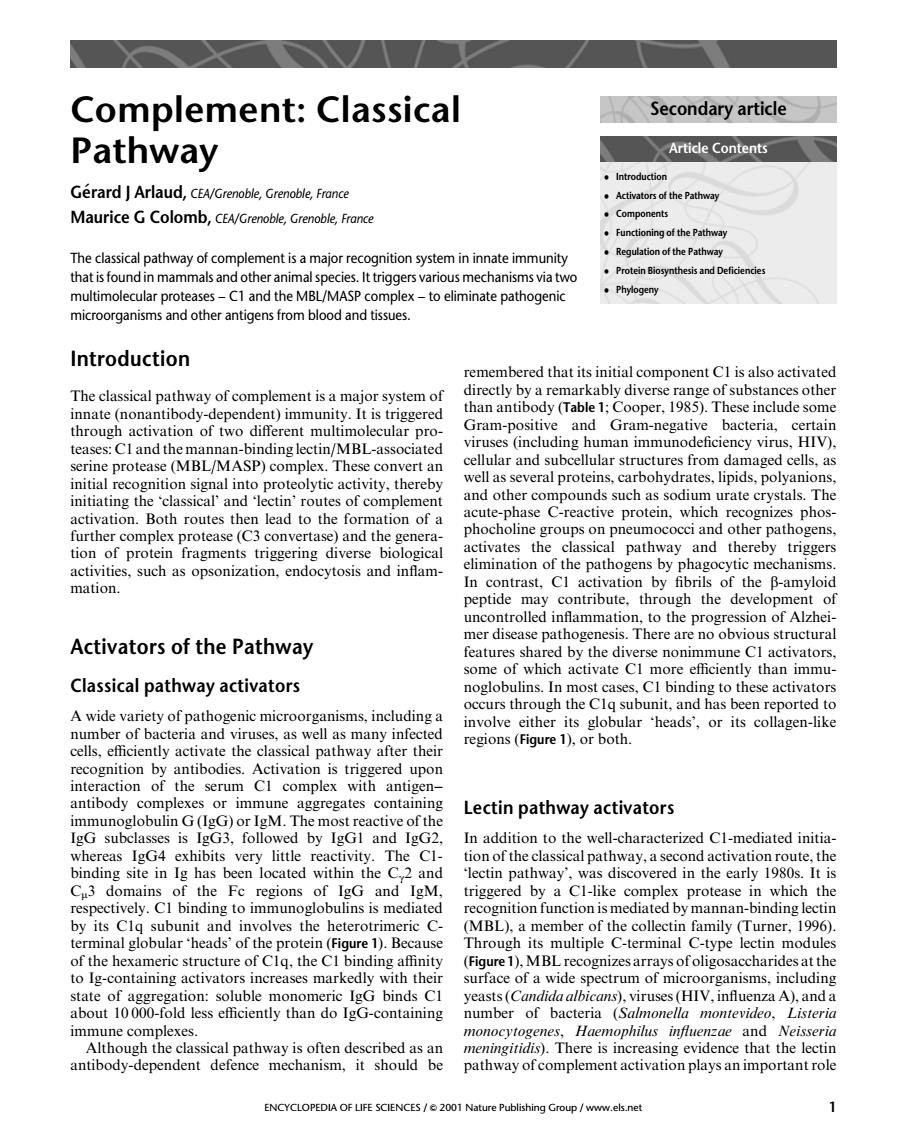正在加载图片...

Complement:Classical Secondary article Pathway Artice Contents Gerard Arlaud,CEA/Grenoble,Grenoble,France the Path Maurice G Colomb,CEA/Grenoble,Grenoble,France The classical pathway of complement isa major re mals and other ar montemninitem olecular roteases-C1 and the MBL/MASP c trigg oennaiepai thogenic Introduction remembered that its initial component Cl is also activated The classical pathw or system of directly by a remarkably diverse range of substances other than antibody(Table 1:Cooper,1985).These include some mate monmody-ccpenden Gr teases:CI and the mannan-binding lectin/MBL-associated Gram-posmven am-negative bactera.cemv serine protease(MBL/MASP)complex.These convert an cellular and subcellular structures from damag ed cells as well as several proteins,carbohydrates,lipids,polyanions, and other compounds such as sodi vation Both murate crystals.The tes the lead to the fo C-reactive protein,w pno further complex protease(C3 convertase)and the genera erse biological activates the classical pathway and thereby trigger elimination of the pathogens by phagocytic mechanisms In contrast,Cl act vation by peptide may ntribute the mer disease pathogenesis.There are no obvious structural Activators of the Pathway features shared by the diverse nonimmune Cl activators, ch activate CI more efficiently than immu Classical pathway activators ac rted to cells.efficiently activate the classical pathway after their regions(Figure 1),or both. ng Lectin pathway activators IgG subclasses is IgG3.followed by IgGl and IgG2. In addition to the well-characterized Cl-mediated initia whereas IgG4 exhibits very little reactivity.The Cl- tion of the classical pathway,a second activation route,the binding site in Ig has been oc cated w ithin the an ectin path way,w discovered in the early 1980 EceioneobleCand ctin by its Clg subunit and involves the heterotrimeric C- (MBL).a member of the collectin family (Turner,1996). terminal globular'heads'of the protein(Figure 1).Because Through its multiple C-terminal C-type lectin modules .the Cl binding afinity A) about 10000-fold less than do IG-containing number of bacteria (Salmonella montevideo. immune complexes. monocytogenes,Haemophilus influenzae and Neisseria ENCYCLOPEDIA OF LIFE SCIENCES/2001 Nature Publishing Group/www.els.net Complement: Classical Pathway Ge´rard J Arlaud, CEA/Grenoble, Grenoble, France Maurice G Colomb, CEA/Grenoble, Grenoble, France The classical pathway of complement is a major recognition system in innate immunity that is found in mammals and other animal species. It triggers various mechanisms via two multimolecular proteases – C1 and the MBL/MASP complex – to eliminate pathogenic microorganisms and other antigens from blood and tissues. Introduction The classical pathway of complement is a major system of innate (nonantibody-dependent) immunity. It is triggered through activation of two different multimolecular proteases: C1 and the mannan-binding lectin/MBL-associated serine protease (MBL/MASP) complex. These convert an initial recognition signal into proteolytic activity, thereby initiating the ‘classical’ and ‘lectin’ routes of complement activation. Both routes then lead to the formation of a further complex protease (C3 convertase) and the generation of protein fragments triggering diverse biological activities, such as opsonization, endocytosis and inflammation. Activators of the Pathway Classical pathway activators A wide variety of pathogenic microorganisms, including a number of bacteria and viruses, as well as many infected cells, efficiently activate the classical pathway after their recognition by antibodies. Activation is triggered upon interaction of the serum C1 complex with antigen– antibody complexes or immune aggregates containing immunoglobulin G (IgG) or IgM. The most reactive of the IgG subclasses is IgG3, followed by IgG1 and IgG2, whereas IgG4 exhibits very little reactivity. The C1- binding site in Ig has been located within the Cg2 and Cm3 domains of the Fc regions of IgG and IgM, respectively. C1 binding to immunoglobulins is mediated by its C1q subunit and involves the heterotrimeric Cterminal globular ‘heads’ of the protein (Figure 1). Because of the hexameric structure of C1q, the C1 binding affinity to Ig-containing activators increases markedly with their state of aggregation: soluble monomeric IgG binds C1 about 10 000-fold less efficiently than do IgG-containing immune complexes. Although the classical pathway is often described as an antibody-dependent defence mechanism, it should be remembered that its initial component C1 is also activated directly by a remarkably diverse range of substances other than antibody (Table 1; Cooper, 1985). These include some Gram-positive and Gram-negative bacteria, certain viruses (including human immunodeficiency virus, HIV), cellular and subcellular structures from damaged cells, as well as several proteins, carbohydrates, lipids, polyanions, and other compounds such as sodium urate crystals. The acute-phase C-reactive protein, which recognizes phosphocholine groups on pneumococci and other pathogens, activates the classical pathway and thereby triggers elimination of the pathogens by phagocytic mechanisms. In contrast, C1 activation by fibrils of the b-amyloid peptide may contribute, through the development of uncontrolled inflammation, to the progression of Alzheimer disease pathogenesis. There are no obvious structural features shared by the diverse nonimmune C1 activators, some of which activate C1 more efficiently than immunoglobulins. In most cases, C1 binding to these activators occurs through the C1q subunit, and has been reported to involve either its globular ‘heads’, or its collagen-like regions (Figure 1), or both. Lectin pathway activators In addition to the well-characterized C1-mediated initiation of the classical pathway, a second activation route, the ‘lectin pathway’, was discovered in the early 1980s. It is triggered by a C1-like complex protease in which the recognition function is mediated by mannan-binding lectin (MBL), a member of the collectin family (Turner, 1996). Through its multiple C-terminal C-type lectin modules (Figure1),MBL recognizes arrays of oligosaccharides at the surface of a wide spectrum of microorganisms, including yeasts (Candida albicans), viruses (HIV, influenza A), and a number of bacteria (Salmonella montevideo, Listeria monocytogenes, Haemophilus influenzae and Neisseria meningitidis). There is increasing evidence that the lectin pathway of complement activation plays an important role Article Contents Secondary article . Introduction . Activators of the Pathway . Components . Functioning of the Pathway . Regulation of the Pathway . Protein Biosynthesis and Deficiencies . Phylogeny ENCYCLOPEDIA OF LIFE SCIENCES / & 2001 Nature Publishing Group / www.els.net 1